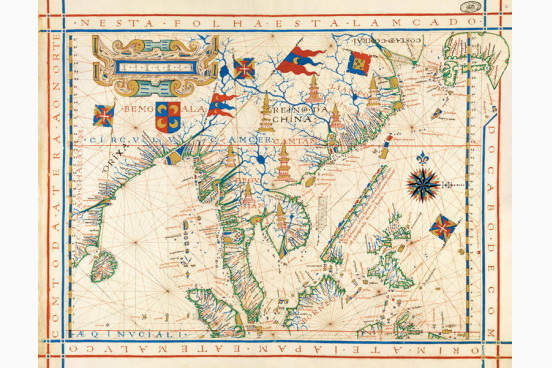This outstanding atlas was created in 1571 in Goa by Fernão Vaz Dourado (c. 1520 – c. 1580), one of the most important cartographers of the sixteenth century. It depicts the known world at the time in a very lavish way, with an accurate representation of the coasts of the continents. Following the tradition of early modern Portuguese mapmaking, this atlas stands out for the quality of its accuracy and abundance of iconographic details.
Although little is known about its author, this atlas is an interesting example of the artistic quality of his charts, which are more like artistic works than mere cartographic representations. The atlas is now housed in the Torre do Tombo National Archive in Lisbon, and is one of the most valuable atlases in its collection.
A Luxury View of the World
The atlas is made on parchment and measures 40.5 x 53 cm. It contains fifteen charts and three tables of solar declination. The charts represent the whole world known by Europeans in the sixteenth century, except the north and south poles, with remarkable accuracy and an outstanding quality of design and decoration.
Using lavish colors like blue and gold, the continents and oceans are filled with abundant decorative elements, such as flags, coats of arms, and elaborated compass roses. For example, the chart that represents Europe and northwestern Africa includes the coats of arms of various kingdoms, such as Portugal, Castile, France (with the fleur-de-lis), and the Papal States.
In the oceans, very elaborate compass roses share the space with abundant islands, colored mainly with gold, blue and red; and the cartographer also includes specific kinds of buildings to indicate several regions like China and the Far East, where we can see numerous pagodas, colored in red and gold.
In fact, the charts of Asia contained in this atlas are among the most accurate maps of the Far East and its islands of the time. India and its coasts are also remarkably portrayed, with a very accurate coastline and abundant decorative elements. This is easily understandable, since Vaz Dourado, according to the sources, was born and raised in India, and this atlas was created in Goa.
The representation of America is also very interesting. It depicts the New World showing ample geographical and historical information, such as the line of demarcation according to the Treaty of Tordesillas, and the strait at the southern tip of South America discovered by Magellan.
Topographical features are abundant, and, in North America, we can see the representation of California. In fact, Vaz Dourado was one of the first Portuguese cartographers to represent California in his maps, only preceded by Bartolomeu Velho (1560) and Sebastião Lopes (1565).
The decorative elements of the atlas are the result of thorough, fine work, using the highest quality of colors and techniques. Such details have allowed researchers to suggest that Vaz Dourado was more of a miniaturist than a mapmaker, being the creator of some of the most beautifully decorated charts of the time.
Fernão Vaz Dourado’s Atlas is currently held in the Torre do Tombo National Archive in Lisbon, under the shelmark Colecção Cartográfica, n.º 165.
An Atlas' Journey Through the Libraries of Noblemen and Monasteries
According to the historian of cartography Armando Cortesão, this atlas was given by D. Francisco da Costa (1532-1591), captain of Malaca (1564) and governor of Algarve (1579) to Teotónio de Bragança (1530-1602), an important noble of Portugal.
Soon after the death of Teotónio de Bragança, the atlas was sent to the library of the Carthusian Monastery of Santa María de Scala Coeli in Évora, where it remained until the nineteenth century, although it had been sent to Portugal to be copied in 1799, being returned to the Monastery in 1806.
After the decree of dissolution of Portuguese monastic orders in 1834, the atlas was sent to the Torre do Tombo National Archive, where it is housed today.
We have 1 facsimile edition of the manuscript "Universal Atlas of Fernão Vaz Dourado": Atlas universal de Fernão Vaz Dourado facsimile edition, published by M. Moleiro Editor, 2011-2013
Request Info / Price

